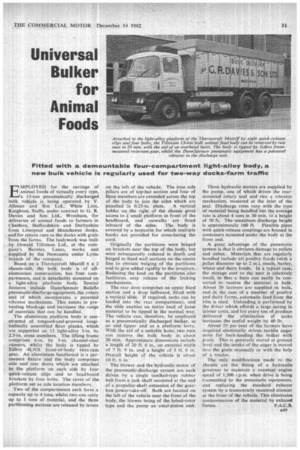• Universal Bulker for Animal Foods
Page 75

If you've noticed an error in this article please click here to report it so we can fix it.
Fitted with a demountable four-compartment light-alloy body, a new bulk vehicle is regularly used for two-way docks-farm traffic EMPLOYED for the carriage of animal foods of virtually every type, a 13-ton pneumatically discharged bulk vehicle is being . operated by V. Allman and Son Ltd.; White Lion, Knighton, Staffs, under contract to G. R. Davies and Son Ltd., Wrexham, for deliveries of animal foods to farmers in Cheshire, Staffordshire and Derbyshire from Liverpool and Manchester docks, and for return runs to the docks with grain from the farms. The bodywork was built by Oswald Tillotson Ltd., at the company's . Burnley, Lanes, works and supplied by the Newcastle under Lyme branch of the company.
Based on a Thornycroft Mastiff 6 x 2 chassis-cab, the bulk body is of allaluminium construction, has four compartments, and is detachably mounted on a light-alloy platform body. Special features include DunnSpencer Bulkilo pneumatic-discharge equipment, the rotary seal of which incorporates a patented vibrator mechanism. This assists in preventing blockage and increases the range of materials that can be handled.
The aluminium platform body is constructed of tongued-and-grooved longitudinally assembled floor planks, which are supported on 12 light-alloy 3-in. by 2.5-iit cross members. The lifting frame comprises 6-in. by 3-in, channel-steel runners, whilst the body is tipped by Edbro 4LNX front-of-body twin-ram gear. An aluminium headboard is a permanent fixture and the body comprises side and rear doors which are attached to the platform on each side by four quick-release clips and to headboard brackets by four bolts. The raves of the platform act as side location members.
. Two of the compartments each have a capacity up to 4 tons, whilst two can carry up to 3 tons of material, and the three partitioning sections are released by levers
on the left of the vehicle. The nine side pillars are of top-hat section and four of these members are extended across the top of the body to join the sides which are panelled in 0.25-in. plate. A vertical ladder on the right of the chassis gives access to a small platform in front of the headboard, and catwalks are fitted inboard of the sides. The body is covered by a tarpaulin for which multiple hooks are provided for cross-Iaeing the cord.
• Originally the partitions were hinged on brackets near the top of the body, but were subsequently reduced in depth and hinged to fixed wall sections on the centre line to obviate bulging of the partitions and to give added rigidity to the structure. Reducing the load on the partitions also facilitates easy release of the locking mechanisms.
The rear door comprises an upper fixed section and a drop tailboard, fitted with a vertical slide. If required, sacks can be loaded into the rear Compartment, and the slide enables an entire load of loose material to be tipped in the normal way. The vehicle can, therefore, be employed as a pneumatically discharged bulker, as an end tipper and as a platform lorry. With the aid of a suitable hoist, two men can remove the bulk body in about 20 min. Approximate dimensions include a length of 20 ft. 6 in., an external width of 7 ft. 9 in. and a height of 5 ft. 6 in. Overall height of the vehicle is about 10 ft. 6 in.
The blower and the hydraulic motor of the pneumatic-discharge system are each driven by a single toothed-type rubber belt from a jack shaft mounted at the end of a propeller-shaft extension of the gearbox power-take-off. Both are located on the left of the vehicle near the front of the body, the blower being of the lobed-rotor type and the pump an axial-piston unit. Three hydraulic motors are supplied by the pump, one of which drives" the rearmounted rotary seal and two a vibrator mechanism, mounted at the inlet of the seal. Discharge rates vary with the type of material being handled but the average rate is about 4 tons in 30 min. to a height of 50 ft: The maximum discharge height is approximately 160 ft. Flexible pipes with quick-release couplings are housed in containers mounted under the body at the front end.
A great advantage of the pneumatic system is that ii obviates damage to pellets and cubes. Materials that are regularly handled include all poultry foods (with a pellet diameter up to 2 in.), meals, barley, wheat and dairy foods. In a typical case, the storage cost to the user is relatively small, in that a barn can easily be converted to. receive the material in bulk. About 30 farmers are supplied in hulk, and in the case of a number of poultry and dairy farms, automatic feed from the bins is used. Unloading is performed by the driver which affords a large saving in labour costs, and for every ton of produce delivered the elimination of sacks increases the useful weight by 40 lb, About 25 per cent of the farmers have acquired electrically driven mobile auger units for back-loading the bulker with grain: This is generally stored at ground level and the intake of the auger is moved into the grain manually or with the help of a tractor.
The only modifications made to the chassis are the fitting of a hydraulic governor to maintain a constant engine speed of 1,500 r.p.m. when drive is being transmitted to the pneumatic equipment, and replacing the standard exhaust system by a transversely mounted silencer at the front of the vehicle. This eliminates contamination of the material by exhaust fumes.




















































































































